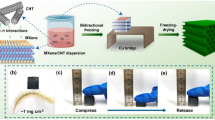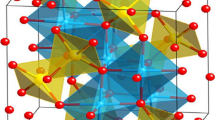Abstract
In recent years, activated carbon materials have been widely used as electrode materials in supercapacitors due to their excellent electrical conductivity, huge specific surface area and chemical stability. A sugarcane tip-based nitrogen-doped activated carbon was prepared by using sugarcane tips as raw material, KOH as an activator and urea as a nitrogen dopant under a simultaneous doping process. The prepared activated carbon has a multilayer pore structure, and the N doping leads to the formation of nitrogen-containing functional groups on the surface of the activated carbon. The sample has a reasonable pore size distribution, a suitable specific surface area and graphitization when the urea doping ratio is 1:2 (NACST-2). Here, MXene/AC composite film materials were rationally designed and successfully synthesized by using nitrogen-doped activated carbon from sugarcane tips as an intercalator to prevent MXene buildingup, broadening ion transport channels and increasing active site utilization, what’s more, the activated carbon can provide additional specific capacitance to the films and improve the overall specific capacitance. The prepared MXene/AC-5% membrane electrode has the best electrochemical performance: the specific capacitance value is 272.7 F/g at a current density of 0.5 A/g.








Similar content being viewed by others
References
Chen, T.T., L. Luo, L.C. Luo, J.P. Deng, X. Wu, M.Z. Fan, G.B. Du, and W.G. Zhao. 2021. High energy density supercapacitors with hierarchical nitrogen-doped porous carbon as active material obtained from bio-waste. Renewable Energy 175: 760–769.
Dubey, P., V. Shrivastav, P.H. Maheshwari, and S. Sundriyal. 2020. Recent advances in biomass derived activated carbon electrodes for hybrid electrochemical capacitor applications: challenges and opportunities. Carbon 170: 1–29.
Du, F., H. Tang, L.M. Pan, T. Zhang, H.M. Lu, J. Xiong, J. Yang, and C. Zhang. 2017. Environmental friendly scalable production of colloidal 2D titanium carbonitride MXene with minimized nanosheets restacking for excellent cycle life lithium-ion batteries. Electrochimica Acta 235: 690–699.
Fu, Q.S., X.Y. Wang, N. Zhang, J. Wen, L. Li, H. Gao, and X.T. Zhang. 2018. Self-assembled Ti3C2Tx/SCNT composite electrode with improved electrochemical performance for supercapacitor. Journal of Colloid and Interface Science 511: 128–134.
Ghidiu, M., M.R. Lukatskaya, M.Q. Zhao, Y. Gogotsi, and M.W. Barsoum. 2014. Conductive two-dimensional titanium carbide “clay” with high volumetric capacitance. Nature 516 (7529): 78-U171.
Gao, Y., W.L. Zhang, Q.Y. Yue, B.Y. Gao, Y.Y. Sun, J.J. Kong, and P. Zhao. 2014. Simple synthesis of hierarchical porous carbon from Enteromorpha prolifera by a self-template method for supercapacitor electrodes. Journal of Power Sources 270: 403–410.
He, X.J., H. Ma, J.X. Wang, Y.Y. Xie, N. Xiao, and J.S. Qiu. 2017. Porous carbon nanosheets from coal tar for high-performance supercapacitors. Journal of Power Sources 357: 41–46.
Jain, A., and S.K. Tripathi. 2015. Nano-porous activated carbon from sugarcane waste for supercapacitor application. Journal of Energy Storage 4: 121–127.
Jiang, X.C., Guo, F.Q., Jia, X.P., Zhan, Y.B., Zhou, H.M.,Qian, L. 2020. Synthesis of nitrogen-doped hierarchical porous carbons from peanut shell as a promising electrode material for high-performance supercapacitors. Journal of Energy Storage 30
Kesavan, T., T. Partheeban, M. Vivekanantha, M. Kundu, G. Maduraiveeran, and M. Sasidharan. 2019. Hierarchical nanoporous activated carbon as potential electrode materials for high performance electrochemical supercapacitor. Microporous and Mesoporous Materials 274: 236–244.
Lin, Y., Z.Y. Chen, C.Y. Yu, and W.B. Zhong. 2019. Heteroatom-doped sheet-like and hierarchical porous carbon based on natural biomass small molecule peach gum for high-performance supercapacitors. Acs Sustainable Chemistry Engineering 7 (3): 3389–3403.
Li, P.L., Y.H. Wang, M. Shang, L.F. Wu, and X.X. Yu. 2020. Enhanced optical limiting properties of graphene oxide-ZnS nanoparticles composites. Carbon 159: 1–8.
Li, J., Wang, Y., Li, X., Gao, Q.,Zhang, S. 2021. A facile synthesis of high-crystalline g-C3N4 nanosheets with closed self-assembly strategy for enhanced photocatalytic H2 evolution. Journal of Alloys and Compounds 881
Lin, G.X., R.G. Ma, Y. Zhou, Q. Liu, X.P. Dong, and J.C. Wang. 2018. KOH activation of biomass-derived nitrogen-doped carbons for supercapacitor and electrocatalytic oxygen reduction. Electrochimica Acta 261: 49–57.
Li, J.X., K.H. Han, J.H. Qi, Z.C. Teng, M. Li, and M.M. Wang. 2019. Biomass-derived 3D hierarchical porous carbon by two-step activation method for supercapacitor. Journal of Materials Science-Materials in Electronics 30 (21): 19415–19425.
Liu, Z.L., Tian, D., Shen, F., Nnanna, P.C., Hu, J.G., Zeng, Y.M., Yang, G., He, J.S.,Deng, S.H. 2020. Valorization of composting leachate for preparing carbon material to achieve high electrochemical performances for supercapacitor electrode. Journal of Power Sources 458
Miao, H., S.H. Li, Z.H. Wang, S.S. Sun, M. Kuang, Z.P. Liu, and J.L. Yuan. 2017. Enhancing the pyridinic N content of nitrogen-doped graphene and improving its catalytic activity for oxygen reduction reaction. International Journal of Hydrogen Energy 42 (47): 28298–28308.
Nasrullah, A., B. Saad, A.H. Bhat, A.S. Khan, M. Danish, M.H. Isa, and A. Naeem. 2019. Mangosteen peel waste as a sustainable precursor for high surface area mesoporous activated carbon: characterization and application for methylene blue removal. Journal of Cleaner Production 211: 1190–1200.
Nie, Z.G., Wang, Y., Li, X.Y., Wang, R., Zhao, Y., Song, H.,Wang, H. 2021. Heteroatom-doped hierarchical porous carbon from corn straw for high-performance supercapacitor. Journal of Energy Storage 44
Okonkwo, C.A., Menkiti, M.C., Obiora-Okafo, I.A.,Ezenwa, O.N. 2021. Controlled pyrolysis of sugarcane bagasse enhanced mesoporous carbon for improving capacitance of supercapacitor electrode. Biomass Bioenergy 146
Ochai-Ejeh, F.O., A. Bello, J. Dangbegnon, A.A. Khaleed, M.J. Madito, F. Bazegar, and N. Manyala. 2017. High electrochemical performance of hierarchical porous activated carbon derived from lightweight cork (Quercus suber). Journal of Materials Science 52 (17): 10600–10613.
Pourjavadi, A., Abdolmaleki, H., Doroudian, M.,Hosseini, S.H. 2020. Novel synthesis route for preparation of porous nitrogen-doped carbons from lignocellulosic wastes for high performance supercapacitors. Journal of Alloys and Compounds 827
Qu, S.S., J.F. Wan, C.C. Dai, T.Y. Jin, and F.W. Ma. 2018. Promising as high-performance supercapacitor electrode materials porous carbons derived from biological lotus leaf. Journal of Alloys and Compounds 751: 107–116.
Sesuk, T., Tammawat, P., Jivaganont, P., Somton, K., Limthongkul, P.,Kobsiriphat, W. 2019. Activated carbon derived from coconut coir pith as high performance supercapacitor electrode material. Journal of Energy Storage 25
Sun, K.L., S.S. Yu, Z.L. Hu, Z.H. Li, G.T. Lei, Q.Z. Xiao, and Y.H. Ding. 2017. Oxygen-containing hierarchically porous carbon materials derived from wild jujube pit for high-performance supercapacitor. Electrochimica Acta 231: 417–428.
Song, Z.Y., D.Z. Zhu, L.C. Li, T. Chen, H. Duan, Z.W. Wang, Y.K. Lv, W. Xiong, M.X. Liu, and L.H. Gan. 2019. Ultrahigh energy density of a N, O codoped carbon nanosphere based all-solid-state symmetric supercapacitor. Journal of Materials Chemistry A 7 (3): 1177–1186.
Shang, Z., X.Y. An, H. Zhang, M.X. Shen, F. Baker, Y.X. Liu, L.Q. Liu, J. Yang, H.B. Cao, Q.L. Xu, H.B. Liu, and Y.H. Ni. 2020. Houttuynia-derived nitrogen-doped hierarchically porous carbon for high-performance supercapacitor. Carbon 161: 62–70.
Tang, Q., Z. Zhou, and P.W. Shen. 2012. Are MXenes promising anode materials for li ion batteries? computational studies on electronic properties and Li storage capability of Ti3C2 and Ti3C2X2 (X = F, OH) monolayer. Journal of the American Chemical Society 134 (40): 16909–16916.
Tang, D.Y., Y.Y. Luo, W.D. Lei, Q. Xiang, W. Ren, W.C. Song, K. Chen, and J. Sun. 2018. Hierarchical porous carbon materials derived from waste lentinus edodes by a hybrid hydrothermal and molten salt process for supercapacitor applications. Applied Surface Science 462: 862–871.
Wang, X., Z.Y. Gao, J.L. Chang, D.P. Wu, X.R. Wang, F. Xu, Y.M. Guo, and K. Jiang. 2015. Electrochemical energy storage and adsorptive dye removal of Platanus fruit-derived porous carbon. Rsc Advances 5 (21): 15969–15976.
Wang, J., P. Nie, B. Ding, S.Y. Dong, X.D. Hao, H. Dou, and X.G. Zhang. 2017. Biomass derived carbon for energy storage devices. Journal of Materials Chemistry A 5 (6): 2411–2428.
Wang, Y.G., Y.F. Song, and Y.Y. Xia. 2016a. Electrochemical capacitors: mechanism, materials, systems, characterization and applications. Chemical Society Reviews 45 (21): 5925–5950.
Wang, Y.L., H.Q. Xuan, G.X. Lin, F. Wang, Z. Chen, and X.P. Dong. 2016b. A melamine-assisted chemical blowing synthesis of N-doped activated carbon sheets for supercapacitor application. Journal of Power Sources 319: 262–270.
Wei, X.J., Y.B. Li, and S.Y. Gao. 2017. Biomass-derived interconnected carbon nanoring electrochemical capacitors with high performance in both strongly acidic and alkaline electrolytes. Journal of Materials Chemistry A 5 (1): 181–188.
Yao, Q.F., H.W. Wang, C. Wang, C.D. Jin, and Q.F. Sun. 2018. One step construction of nitrogen-carbon derived from bradyrhizobium japonicum for supercapacitor applications with a soybean leaf as a separator. Acs Sustainable Chemistry Engineering 6 (4): 4695–4704.
Yu, P.F., Y.R. Liang, H.W. Dong, H. Hu, S.M. Liu, L. Peng, M.T. Zheng, Y. Xiao, and Y.L. Liu. 2018. Rational synthesis of highly porous carbon from waste bagasse for advanced supercapacitor application. ACS Sustainable Chemistry Engineering 6 (11): 15325–15332.
Yan, J., Ren, C.E., Maleski, K., Hatter, C.B., Anasori, B., Urbankowski, P., Sarycheva, A.,Gogotsi, Y.2017. Flexible MXene/graphene films for ultrafast supercapacitors with outstanding volumetric capacitance. Advanced Functional Materials 27(30)
Zhang, Y.X., and Y.H. Wang. 2017. Nonlinear optical properties of metal nanoparticles: a review. Rsc Advances 7 (71): 45129–45144.
Zhang, L.L., and X.S. Zhao. 2009. Carbon-based materials as supercapacitor electrodes. Chemical Society Reviews 38 (9): 2520–2531.
Zeng, J., Q. Cao, X. Peng, and X.X. Peng. 2016. Hierarchical porous nitrogen doping activated carbon with high performance for supercapacitor electrodes. Rsc Advances 6 (19): 15320–15326.
Zhang, P., Zhu, Q.Z., Soomro, R.A., He, S.Y., Sun, N., Qiao, N.,Xu, B. 2020. In situ ice template approach to fabricate 3D flexible MXene film-based electrode for high performance supercapacitors. Advanced Functional Materials 30(47)
Acknowledgements
The authors gratefully express gratitude to all parties who have contributed toward the success of this project. This work was supported by the Research program of Agriculture Research System of China(CARS-170502), the supported by China Agriculture Research System of Ministry of Finance (MOF) and Ministry of Agriculture and Rural Affairs(MARA).
Author information
Authors and Affiliations
Corresponding author
Ethics declarations
Conflict of interest
The authors declare that they have no conflict of interest.
Additional information
Publisher's Note
Springer Nature remains neutral with regard to jurisdictional claims in published maps and institutional affiliations.
Rights and permissions
Springer Nature or its licensor (e.g. a society or other partner) holds exclusive rights to this article under a publishing agreement with the author(s) or other rightsholder(s); author self-archiving of the accepted manuscript version of this article is solely governed by the terms of such publishing agreement and applicable law.
About this article
Cite this article
Zhou, H., Wang, C., Lu, W. et al. MXene/AC Composite Membranes as an Electrode Material for Flexible Supercapacitors with Excellent Properties. Sugar Tech 25, 982–994 (2023). https://doi.org/10.1007/s12355-022-01237-w
Received:
Accepted:
Published:
Issue Date:
DOI: https://doi.org/10.1007/s12355-022-01237-w




